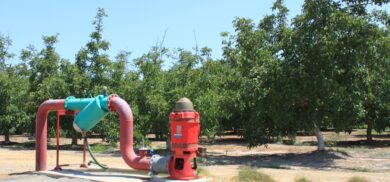Can California cropland be repurposed for community solar?
 “When you think of solar power, California undoubtedly comes to mind. The state’s strong climate goals paired with abundant sunshine have helped California reach record rooftop and utility-scale solar buildout. But surprisingly, its community solar programs (not to be confused with community choice aggregation) haven’t been able to gain traction. Out of the 5,700 megawatts of installed community solar in the country, less than 1% of that is in California. And for perspective, California has more than 40,000 megawatts of installed solar capacity. Unfortunately, the state’s current community solar programs haven’t been able to incentivize these projects. … ” Read more from the Union of Concerned Scientists.
“When you think of solar power, California undoubtedly comes to mind. The state’s strong climate goals paired with abundant sunshine have helped California reach record rooftop and utility-scale solar buildout. But surprisingly, its community solar programs (not to be confused with community choice aggregation) haven’t been able to gain traction. Out of the 5,700 megawatts of installed community solar in the country, less than 1% of that is in California. And for perspective, California has more than 40,000 megawatts of installed solar capacity. Unfortunately, the state’s current community solar programs haven’t been able to incentivize these projects. … ” Read more from the Union of Concerned Scientists.
Sacramento Valley
Measuring and monitoring are essential to groundwater sustainability
 “Each spring groundwater levels are measured throughout the Sacramento Valley, including here in Butte County. As Watching Groundwater Level Recover in the Sacramento Valley noted earlier this year, water resources managers, Groundwater Sustainability Agencies (GSAs) and landowners throughout the Sacramento Valley are watching groundwater levels and quality to see how the aquifer systems will recover on the heels of some very dry years where there has been little surface water in certain parts of the Valley. We are seeing some encouraging trends on aquifer recovery in Butte County with the wet year and we will continue to monitor and collect important information to ensure the sustainable management of our groundwater resources. … ” Read more from the Northern California Water Association.
“Each spring groundwater levels are measured throughout the Sacramento Valley, including here in Butte County. As Watching Groundwater Level Recover in the Sacramento Valley noted earlier this year, water resources managers, Groundwater Sustainability Agencies (GSAs) and landowners throughout the Sacramento Valley are watching groundwater levels and quality to see how the aquifer systems will recover on the heels of some very dry years where there has been little surface water in certain parts of the Valley. We are seeing some encouraging trends on aquifer recovery in Butte County with the wet year and we will continue to monitor and collect important information to ensure the sustainable management of our groundwater resources. … ” Read more from the Northern California Water Association.
Groundwater political group protests Tuscan Water District
“A proposed special district in Butte County that would carry out groundwater recharge projects, known as the Tuscan Water District, has met controversy in its formation process. Political group Groundwater for Butte began a public campaign Tuesday in a ballot-ripping protest at Durham Community Park held in opposition to the district’s formation for many reasons, one being a lack of public information and input on the matter. The district has gone through Butte County’s agency formation process, and it is said county supervisors are set to vote as soon as Tuesday on whether or not to place the district’s formation on an official election ballot. According to its website, the formation of the Tuscan Water District attempts to fill a water-management void in the area of the Vina subbasin and a portion of the Butte subbasin. … ” Read more from the Chico Enterprise-Record.
Butte County groundwater agencies approve fees; DWR approves plans
“Fees to support two groundwater sustainability agencies that cover the majority of urban Butte County have been passed this week and will be placed on the 2023-2024 assessor’s property tax roll. The boards for the Vina GSA and the Wyandotte Creek GSA on Wednesday and Thursday approved their budgets at public meetings where residents protested the fees and did not succeed in stopping them. In addition to fees being passed, all three groundwater sustainability plans for the Vina subbasin, Wyandotte Creek subbasin and the Butte subbasin have been approved by the Department of Water Resources. … ” Read more from the Chico Enterprise-Record.
Rural residents, farmers bring groundwater-sustainability issues to Yolo County supervisors
“The Yolo County Board of Supervisors showed themselves to be — as one individual referred to himself in the public comments — “ag-vocates” in the board meeting on Tuesday, July 11. Not only did they approve the acceptance of a sizeable grant from the California Department of Parks and Recreation, but the supervisors also addressed the seriousness of groundwater-sustainability issues raised by small farmers and rural residents in Yolo County’s areas of special concern. The board received an update on the drought and current groundwater conditions spearheaded by the Yolo County manager of natural resources, Elissa Sabatini. She delved into reports of the dry wells popping up around Yolo County, which include 49 confirmed since 2021, 21 of those remaining dry; and the fact that there have been no reports since March of 2023. Sabatini also mentioned a current petition making the rounds on change.org to stop drilling new wells on historically non-irrigated land of Yolo County. … ” Read more from the Winters Express.
San Joaquin Valley
Kings County: Local water district challenges water export ordinance
“Corcoran area water district El Rico GSA has sued Kings County over the county’s new groundwater export ordinance. The lawsuit, received June 8, says the County did not follow the California Environmental Quality Act (CEQA) procedures that they are mandated to follow. The district says the ordinance, passed Nov. 29, 2022 was adopted with only one hearing in a few weeks’ time. not allowing for input from water agencies. The news that the County wanted to move forward on the ordinance was met with criticism from a number of local water entities. El Rico maintains that allowing time for input could have ironed out problems they say include the issue of groundwater imports into the county. … ” Read more from the Hanford Sentinel.
SoCAL WATER DIALOG: SGMA implementation in the San Joaquin Valley
Groundwater is a critical resource, supplying nearly 40% of the state with water to support cities and farms. With droughts increasing in severity and frequency and climate change putting stress on local communities across the state, it has become increasingly clear that California can no longer manage groundwater resources as we have in the past. This recognition led to the passage of the Sustainable Groundwater Management Act (SGMA) in 2014 – a law designed to provide statewide guidance for managing California’s precious groundwater resources sustainably. Eight years in, how is the implementation of SGMA going?
In a presentation to the Southern California Water Dialog, Ellen Hanak, vice president and director of the Water Policy Center and a senior fellow at the Public Policy Institute of California (PPIC), gave a status check on SGMA implementation with a focus on the San Joaquin Valley, which is ground zero for SGMA implementation. In the San Joaquin Valley, bringing groundwater basins in to balance will necessitate significant amount of irrigated lands to come out of production. Ann Hayden, Interim Vice President of Climate Resilient Water Systems for the Environmental Defense Fund, discussed how the state’s Multibenefit Land Repurposing Program hopes to help with the transition. … ” Click here to read this article from Maven’s Notebook.
State pays valley farmers millions to keep water in the ground
“The state is sending millions to farmers throughout the San Joaquin Valley to keep water in the ground. The money, paid through the LandFlex program, goes to groundwater sustainability agencies (GSAs) and then directly to farmers, paying them for every acre foot they don’t pump. On July 24, the Department of Water Resources announced awards to the Lower Tule River and Pixley GSAs of $7.7 million and $5 million, respectively, and $4 million to the Westlands Water District GSA. This is the second round of LandFlex funding. … ” Read more from SJV Water.
Cuyama Valley
Commercial carrot growers sued Cuyama Valley residents over groundwater and the first hearing is coming up
 “As the Cuyama Unified School District stepped out of a financial crisis after years of budget struggles, Bolthouse Farms and Grimmway Farms sued the district over groundwater rights. And if the district didn’t join in the adjudication case, it risked losing water rights altogether, Superintendent Alfonso Gamino said. “We have it in our budget for unforeseen expenses. We have more than 5 percent [in reserves], but this was an expense we weren’t counting on and how much more we’re going to have to spend is unknown,” he said. “We have to defend our water rights, but my frustration is that we can finally breathe a little bit and it’s like, ‘Here we go again.’” … The corporations first filed the groundwater rights lawsuit in August 2021 and have continued serving every Cuyama Valley resident who relies on the Cuyama Valley Groundwater Basin. … ” Read more from the Santa Maria Sun.
“As the Cuyama Unified School District stepped out of a financial crisis after years of budget struggles, Bolthouse Farms and Grimmway Farms sued the district over groundwater rights. And if the district didn’t join in the adjudication case, it risked losing water rights altogether, Superintendent Alfonso Gamino said. “We have it in our budget for unforeseen expenses. We have more than 5 percent [in reserves], but this was an expense we weren’t counting on and how much more we’re going to have to spend is unknown,” he said. “We have to defend our water rights, but my frustration is that we can finally breathe a little bit and it’s like, ‘Here we go again.’” … The corporations first filed the groundwater rights lawsuit in August 2021 and have continued serving every Cuyama Valley resident who relies on the Cuyama Valley Groundwater Basin. … ” Read more from the Santa Maria Sun.
Cuyama Valley residents call for boycott of carrots after two growers sue landowners over water rights
“In a battle likened to David versus Goliath, Cuyama Valley residents have launched a boycott of carrots after two giant growers sued all landowners in the community over water rights. Bolthouse Farms and Grimmway Farms are among the plaintiffs for the lawsuit claiming hundreds of defendants — and all property owners — including homeowners, businesses and public agencies in the Cuyama Valley. At the heart of the fight is the rights to the water in the Cuyama Valley Basin, which has been designated among the state’s most overdrafted groundwater basins for years. Overdrafted basins happen when the amount of water pumped out is larger than the long-term average supply of water into the basin. Groundwater remains the lone source since State Water Project delivery isn’t available. … ” Read more from Noozhawk.
Ridgecrest
Ridgecrest: Court to allow amicus briefs in Mojave Pistachios water appeal
“The Fourth Appellate District, Court of Appeal will allow four amicus briefs to be filed in support of Mojave Pistachios in its legal action against the Indian Wells Valley Groundwater Authority according to an order issued by the court last week. “Amicus brief” means literally “friend of the court.” An amicus brief is filed by a person or organization who is not a party to a legal case but who wants to aid the court by providing information or arguments. Mojave Pistachios put out a press release yesterday on the development, but groundwater authority General Counsel Keith Lemieux said the news is no big deal. … ” Read more from the Ridgecrest Independent.
Groundwater Authority working on improving communication and engagement with the community, potentially
“At their board meeting on July 12, the Indian Wells Valley Groundwater Authority discussed their communication and engagement plan. The plan’s goal is to get the IWVGA to do a better job of communicating its important mission of ensuring sustainability of the IWV’s critically overdrafted water source. The IWVGA has a policy advisory committee that drafted the plan. This committee is made up of community members representing various stakeholders in IWV’s groundwater source, such as residents and commercial interests and so on. At the meeting, IWVGA acting general manager Carol Thomas-Keefer described the committee’s plan, and then also described which parts the IWVGA sees as a priority and which it doesn’t. … ” Read more from the Ridgecrest Independent.


















 “The San Joaquin Valley is home to some 4 million residents and growing rapidly: another 1 million residents are expected by 2040. Groundwater is the primary water source for these communities, yet decades of overpumping have stressed the region’s groundwater basins, resulting in land subsidence, dry wells, and falling groundwater reserves. The 2014 Sustainable Groundwater Management Act (SGMA) seeks to solve this issue by mandating that water users bring their groundwater basins back into balance by the 2040s. “Much of the discussion around implementation of the Sustainable Groundwater Management Act in the valley focuses on agriculture,” said PPIC research fellow Andrew Ayres at a virtual event last week. “That makes sense, because agriculture is a key player in SGMA implementation in the valley. Urban areas, though they use much less water, oftentimes are highly reliant on groundwater, so SGMA implementation is very important for them as well.” … ” Read more from the PPIC here:
“The San Joaquin Valley is home to some 4 million residents and growing rapidly: another 1 million residents are expected by 2040. Groundwater is the primary water source for these communities, yet decades of overpumping have stressed the region’s groundwater basins, resulting in land subsidence, dry wells, and falling groundwater reserves. The 2014 Sustainable Groundwater Management Act (SGMA) seeks to solve this issue by mandating that water users bring their groundwater basins back into balance by the 2040s. “Much of the discussion around implementation of the Sustainable Groundwater Management Act in the valley focuses on agriculture,” said PPIC research fellow Andrew Ayres at a virtual event last week. “That makes sense, because agriculture is a key player in SGMA implementation in the valley. Urban areas, though they use much less water, oftentimes are highly reliant on groundwater, so SGMA implementation is very important for them as well.” … ” Read more from the PPIC here: 


